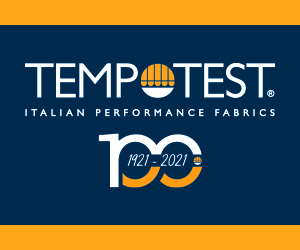Culp Launches Aqua-Lok(tm): Latex-Free, Environmentally Friendly Finish
September 20, 2000
High Point - Culp has achieved a technological breakthrough in the elimination of the latex backing from 20 percent of its product line by using a patented finishing process called Aqua-Lok(tm).
Over the past 18 months, The InterSpun® division of BBA Nonwovens (Pineville, N.C.) developed the process. Culp has an exclusive right to use the new technology for an indeterminate period of time, said Tim Dolan, Culp vice president sales and marketing.
''Eventually, we will use the process to eliminate the need for latex in the backing of all of our products, but right now, it is available on flat woven and tapestry goods,'' he said.
The cost savings to Culp is being passed on to the customer in the form of more face yarns and softer hand without the need for latex in the backing, he said. ''The latex-backed product had to be softened after the raveling and curling process,'' he said. ''The new process is better because there is no latex entering the environment or the water supply for recycling.
In the past Culp and other mills achieved a soft hand by washing and rewashing the finished fabric several times. The new process eliminates the need for rewashing. The Aqua-Lok process is said to combine the rewashing effects in just one process.
Furthermore, the process shows significant improvements in pilling, abrasion, seam slippage and tensile strength, Culp said. ''The company said it expects that this of technology will meet the needs of its export and domestic customers. Culp Velvet Prints is the next group of products to be affected by the removal of the latex in the finishing process.
The move represents a significant financial investment to Culp. ''The machinery required to finish the goods without latex is expensive,'' Dolan said. ''It is housed in our Burlington, N.C., finishing plant. Two more finishing units are on order from the manufacturer, Fleissner Maschinenfabrik GmbH, Egelsbach, Germany. Plus, we still have to maintain the latex finishing line in four locations.''
The new process has been used successfully in the industrial fabric and apparel fabric market, he said.
The basic process, in use since 1995, calls for the use of high-pressure water onto a woven or knit fabric, thereby changing its structure and the properties of the fabric. The highly complex process uses water jets in the form of a curtain. The energy imparted causes the cloth to bulk and blossom by as much as 50 percent and entangled individual fibers.
With woven fabrics, the yarns are said to be displaced and uniformly redistributed in the fabric. Most of the tension is removed from the fabric inhibiting torquing and edge curling, Culp explained. With this special process, a binding effect is created with a weblike backing called INVISICOAT(tm).
Over the past 18 months, The InterSpun® division of BBA Nonwovens (Pineville, N.C.) developed the process. Culp has an exclusive right to use the new technology for an indeterminate period of time, said Tim Dolan, Culp vice president sales and marketing.
''Eventually, we will use the process to eliminate the need for latex in the backing of all of our products, but right now, it is available on flat woven and tapestry goods,'' he said.
The cost savings to Culp is being passed on to the customer in the form of more face yarns and softer hand without the need for latex in the backing, he said. ''The latex-backed product had to be softened after the raveling and curling process,'' he said. ''The new process is better because there is no latex entering the environment or the water supply for recycling.
In the past Culp and other mills achieved a soft hand by washing and rewashing the finished fabric several times. The new process eliminates the need for rewashing. The Aqua-Lok process is said to combine the rewashing effects in just one process.
Furthermore, the process shows significant improvements in pilling, abrasion, seam slippage and tensile strength, Culp said. ''The company said it expects that this of technology will meet the needs of its export and domestic customers. Culp Velvet Prints is the next group of products to be affected by the removal of the latex in the finishing process.
The move represents a significant financial investment to Culp. ''The machinery required to finish the goods without latex is expensive,'' Dolan said. ''It is housed in our Burlington, N.C., finishing plant. Two more finishing units are on order from the manufacturer, Fleissner Maschinenfabrik GmbH, Egelsbach, Germany. Plus, we still have to maintain the latex finishing line in four locations.''
The new process has been used successfully in the industrial fabric and apparel fabric market, he said.
The basic process, in use since 1995, calls for the use of high-pressure water onto a woven or knit fabric, thereby changing its structure and the properties of the fabric. The highly complex process uses water jets in the form of a curtain. The energy imparted causes the cloth to bulk and blossom by as much as 50 percent and entangled individual fibers.
With woven fabrics, the yarns are said to be displaced and uniformly redistributed in the fabric. Most of the tension is removed from the fabric inhibiting torquing and edge curling, Culp explained. With this special process, a binding effect is created with a weblike backing called INVISICOAT(tm).
















